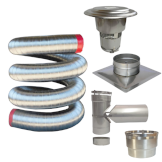I have a Rockford Chimney Liner Kit sitting in my garage. I've also done a lot of research - much of it here, for which I thank you all! 
The fireplace insert and chimney have been cleaned thoroughly, which was long overdue. (The insert came with the house, so this was a learning experience, to say the least.)
I also have some (non-foil-faced) insulation I got from Rockford with the idea of packing it around the bottom of the chimney liner (above the top of the stove) in order to add an odor barrier (of sorts).
What last-minute tips would you have? What do you wish someone had told you the first time you did something like this which wasn't covered in the standard how-to videos?
One thing I see is that my insert has leveling bolts on the rear of the unit. I'm assuming that is just to accommodate slight variances in the brick, etc.
Any other ideas to help me do this 100% on the first try? Planning to do this Saturday and I can't wait!

The fireplace insert and chimney have been cleaned thoroughly, which was long overdue. (The insert came with the house, so this was a learning experience, to say the least.)

I also have some (non-foil-faced) insulation I got from Rockford with the idea of packing it around the bottom of the chimney liner (above the top of the stove) in order to add an odor barrier (of sorts).
What last-minute tips would you have? What do you wish someone had told you the first time you did something like this which wasn't covered in the standard how-to videos?
One thing I see is that my insert has leveling bolts on the rear of the unit. I'm assuming that is just to accommodate slight variances in the brick, etc.
Any other ideas to help me do this 100% on the first try? Planning to do this Saturday and I can't wait!


